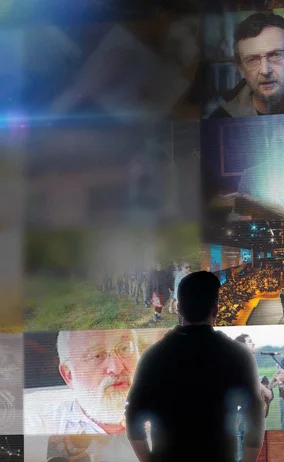New Home › Forums › Course Forums › GE Forum – Ask Connect Inspire › Ask Anything
- This topic has 2,513 replies, 143 voices, and was last updated 1 day, 15 hours ago by
 Gianni – KabU Instructor.
Gianni – KabU Instructor.
- AuthorReplies
- July 11, 2024 at 5:58 pm EDT #379644
 Kimadigital7Participant
Kimadigital7Participant1- How to come to a correct deficiency to bestow?
2- Is it by asking the Creator to give the friends the deficiency or I should pray for the deficiency for myself?- July 12, 2024 at 12:49 am EDT #379663
 Gianni – KabU InstructorModerator
Gianni – KabU InstructorModeratorBoth can work, and there’s more scrutiny required for both. But generally, a prayer outside oneself is more important, much more effective.
- July 11, 2024 at 1:58 pm EDT #379629
 Zorica KostadinovskaParticipant
Zorica KostadinovskaParticipantWhy is Hebrew written from right to left? Thank you!
- July 11, 2024 at 7:10 pm EDT #379646
 Gianni – KabU InstructorModerator
Gianni – KabU InstructorModeratorHebrew is first of all a geometric representation of how the Lights enter the Vessel. And this occurs from Right to Left.
- July 10, 2024 at 7:07 am EDT #379409
 GregParticipant
GregParticipantThe ego is a slippery thing. I think that in many cases, it’s both consciously repressed, (because we like to fool ourselves into being better than we are), or unconsciously. In any case, it keeps us from properly receiving the Light. Is it a good prayer to ask the Creator to reveal our deficiency or should we just assume the ego is there and work on strengthening our intentions toward bestowal?
- July 10, 2024 at 2:03 pm EDT #379434
 Gianni – KabU InstructorModerator
Gianni – KabU InstructorModeratorIt’s best to work toward the good. So, try to reach spirituality. This, by contrast, reveals more of the ego. Only the revelation of evil (the ego) is missing since to the extent of one’s awareness of it, one can’t bear it, and has a true request for change.
- July 9, 2024 at 8:24 am EDT #379108
 DaveParticipant
DaveParticipantIs there any significance to the blue and white color scheme of KabU and Bnei Baruch or is it just Ravs favorite colors?
- July 9, 2024 at 2:35 pm EDT #379223
 Gianni – KabU InstructorModerator
Gianni – KabU InstructorModeratorThere are spiritual roots to colors and their effect on us, as with everything. But that wasn’t foremost in the color scheme. Blue is simply a nice, neutral color.
- July 9, 2024 at 6:15 am EDT #379005
 GregParticipant
GregParticipantGood morning, This morning I read a passage from Attaining the Worlds Beyond pp 152. It reads: ” ” If human beings do not have the desire to regain the power to return to rule their own desires, then they have attained true love of the Creator, rather than a mere subordination to Him.” If I were to replace the word desire with ego in the sentence would it mean the same thing or was the word desire used intentionally? I am a little confused with what this passage is telling me. I have to desire the change/correction in me or nothing happens so isn’t that a form of control?
- July 9, 2024 at 2:48 pm EDT #379226
 Gianni – KabU InstructorModerator
Gianni – KabU InstructorModeratorHi Greg,
You could replace it, but that’s not what the Kabbalist wrote, so I wouldn’t. This text is pretty challenging. It’s for beginners but as you advance you discover more and more depth. Here it’s talking about layers of sensation of the Creator’s control over me, and my corresponding level of agreement with that control. There are many fathoms to this control, which one has to discover, agree with – as His control is hidden in ratio to my lack of readiness to accept it. In the meantime I’m in a completely illusory feeling on control over myself and things around me.
- July 5, 2024 at 4:08 pm EDT #378513
 BradParticipant
BradParticipantHi Gianni
you may have missed my response from last week, regarding “work” and “Shabbat” so ill post it again here.
Wonderful, so, “work” is working on our “ego” and on Shabbat, we let the upper light do the work, or finish the work.
When you said “shabbat is an “inner state” one might reach on a Wednesday etc . A passage from the Talmud came to my mind, maybe you can tell me if it is hinting to this “inner state ? Or approves this idea “between the lines” so to speak?
Shabbat 69b:4-7
Rav Huna said: One who was walking along the way or in the desert, and he does not know when Shabbat occurs, he counts six days from the day that he realized that he lost track of Shabbat and then observes one day as Shabbat. Ḥiyya bar Rav says: He first observes one day as Shabbat and then he counts six weekdays.
thanks
- July 5, 2024 at 8:04 pm EDT #378535
 Gianni – KabU InstructorModerator
Gianni – KabU InstructorModeratorIt’s related. But the commentary on it is much deeper than we can provide here.
- July 5, 2024 at 8:25 pm EDT #378541
 BradParticipant
BradParticipantOkay, if you have some teachings on it, feel free to E-Mail me. [email protected]
Shabbat Shalom!
- July 15, 2024 at 1:51 pm EDT #381460
 Varda kahalanyParticipant
Varda kahalanyParticipantI am also interested in this reply and would be very grateful if when you get a response you could email it to me – [email protected].
Thank you…..
- AuthorReplies
- You must be logged in to reply to this topic.

